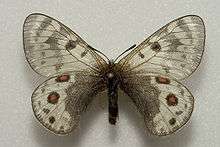Parnassius acdestis
Parnassius acdestis is a high-altitude butterfly found in India. It is a member of the genus Parnassius of the swallowtail family, Papilionidae. The species was first described by Grigory Grum-Grshimailo in 1891.
| Parnassius acdestis | |
|---|---|
 | |
| Female from Lob Noor (Ulster Museum) | |
| Scientific classification | |
| Kingdom: | Animalia |
| Phylum: | Arthropoda |
| Class: | Insecta |
| Order: | Lepidoptera |
| Family: | Papilionidae |
| Genus: | Parnassius |
| Species: | P. acdestis |
| Binomial name | |
| Parnassius acdestis Grum-Grshimailo, 1891 | |
Description
Note: The wing pattern in Parnassius species is inconsistent and the very many subspecies and forms make identification problematic and uncertain. Structural characters derived from the genitalia, wing venation, sphragis and foretibial epiphysis are more, but not entirely reliable. The description given here is a guide only. For an identification key see P.R. Ackery (1975).[1]
Hindwing with very narrow marginal band, the submarginal spots isolated, small; the ultracellular costal spot of forewing continued by grey scaling, forming an s-shaped band.[2]
Subspecies
- Parnassius acdestis cerevisiae Weiss & Michel
- Parnassius acdestis cinerosus Stichel
- Parnassius acdestis felix Eisner
- Parnassius acdestis hades (Bryk)
- Parnassius acdestis imperatoides Weiss & Michel
- Parnassius acdestis irenaephis Bryk
- Parnassius acdestis ladakensis Avinoff, 1916
- Parnassius acdestis lathonius Bryk
- Parnassius acdestis limitis Weiss & Michel
- Parnassius acdestis macdonardi Rothschild
- Parnassius acdestis manco Koiwaya
- Parnassius acdestis ohkuma Koiwaya
- Parnassius acdestis peeblesi Bryk
- Parnassius acdestis peshkei Eisner, 1933
- Parnassius acdestis rupshuana Avinoff, 1916
- Parnassius acdestis takedai Mikami & Sakakibara, 1988
- Parnassius acdestis vogti (Bang-Haas)
- Parnassius acdestis yanae Huang, 1998
Range
Kirghistan, Nepal, northern India (Jammu & Kashmir, Sikkim), western China, Sinkiang and Szechwan.
Status
Very local. Rather rare. Not known to be threatened.
References
- Ackery P.R. (1975) A guide to the genera and species of Parnassiinae (Lepidoptera:Papilionidae). Bulletin of the British Museum (Natural History) (Entomology) 31, 4 pdf
- Stichel in Seitz, 1906 (Parnassius). Die Groß-Schmetterlinge der Erde. Die Groß-Schmetterlinge des palaearktischen Faunengebietes. Die palaearktischen Tagfalter, Stuttgart.
- Collins, N. Mark; Morris, Michael G. (1985). Threatened Swallowtail Butterflies of the World: The IUCN Red Data Book. Gland & Cambridge: IUCN. ISBN 978-2-88032-603-6 – via Biodiversity Heritage Library.
- Evans, W.H. (1932). The Identification of Indian Butterflies (2nd ed.). Mumbai, India: Bombay Natural History Society.
- Wynter-Blyth, Mark Alexander (1957). Butterflies of the Indian Region. Bombay, India: Bombay Natural History Society. ISBN 978-8170192329.
- Sakai S., Inaoka S., Toshiaki A., Yamaguchi S., Watanabe Y., (2002) The Parnassiology. The Parnassius Butterflies, A Study in Evolution, Kodansha, Japan. ISBN 4-06-124051-X
- Weiss Jean-Claude, (1999) Parnassiinae of the World, Hillside Books, Canterbury, UK. ISBN 0-9532240-2-3, OCLC 41072974
Further reading
- sv:Parnassius acdestis - Swedish Wikipedia provides further references and synonymy
